Abstract
Water source identification and dynamic assessment are critical for mining safety, particularly in mines governed by complex geological structures. The hydrochemical mixing model demonstrates a natural advantage for early warning of water intrusion compared to geophysical monitoring techniques. This study discusses core issues related to the mixing model, including the conceptual framework, selection of end-members, and choice of tracers, and formulates principles for general applicability. In this study, three sources were identified using the conceptual model and hydrochemical analysis: water in F7 (main fault), shallow fracture water, and river water. A correlation analysis and variability analysis were applied to determine the tracers, and the 18O, D, Cl, B, and Li were determined. The end-members of the three sources are time-dependent in July and September, especially the shallow fracture water’s end-members. The dynamics of the mixing ratios of the three sources suggest that river water contributes only to the inrush (1–4%), with this being especially low in September, as the increasing hydraulic gradient from south to north prevents recharge. The water in F7 accounts for at least 70% of the inrush water. Shallow fracture water accounts for the rest and increases slightly in September as the precipitation increases in mining-disturbed areas. Finally, this work makes the later water control work more targeted.
1. Introduction
Water inrush represents a significant threat to the safety of mining operations [1,2]. The primary methods employed for the early detection of water inrush include rock strain monitoring and geophysical detection [3]. However, these techniques are limited in their ability to provide timely warnings due to the progressive damage and degradation of fractured rock, which often results in the detection of warning signals only shortly before an actual water inrush event. In contrast, groundwater flow within fissures exhibits a high capacity for migration, allowing it to rapidly reach mining areas or roadways. Monitoring changes in the concentrations of chemical components in groundwater can effectively capture the dynamic variations in the number and proportion of water sources, which is crucial for early warning of water inrush incidents [4].
Mixing phenomena are prevalent in various natural contexts, including sound mixing, air pollutant mixing, groundwater mixing, and electromagnetic signal mixing [5,6,7,8]. The objective of investigating mixing problems is to reconstruct the entire mixing process, identify the various sources of the mixture, and facilitate their separation. In practical applications, obtaining mixed samples is relatively straightforward; however, the complexity and challenges associated with these problems arise from several factors: (1) the abundance of mixed samples, while the source samples are often difficult to acquire; (2) the ambiguity regarding the number of sources involved; and (3) the potential variability in the parameters associated with source samples over time and space. Consequently, addressing such problems frequently necessitates reliance on the characteristics of the mixed samples, often requiring the integration of constraints into the modeling process, which may encompass both mathematical constraints and prior knowledge.
Since the 1970s, hydrochemical mixing models have been extensively employed to investigate the origins and pathways of surface runoff, as well as to pinpoint sources of groundwater contamination [9,10]. Initially, the analyses utilized hydrogen and oxygen isotopes to elucidate the temporal dynamics of the chemical composition of water, thereby distinguishing between “new” and “old” constituents [11,12,13]. Subsequently, some researchers have incorporated additional ions, such as chloride (Cl) and silicon (Si), into these mixing models, enabling the identification of not only the novelty of the water source but also its geographical origins [14]. These models operate under the assumptions that (1) the water is a composite of multiple sources mixed in specific ratios, adhering to the principles of linear mixing without any chemical reactions occurring during the mixing process; and (2) there is minimal temporal and spatial variation in the chemical constituents of the water sources. Nevertheless, hydrochemical mixing models encounter several challenges, including issues related to model scale, analytical methodologies, and the validity and sensitivity of the results. The conceptual framework, along with the principles governing tracer and end-member selection, is critical to addressing these challenges, yet these aspects have received limited attention in the literature. Traditional mixing models, including EMMA, UNMIX, and M3, predominantly identify tracer ions based on the criterion of chemical stability [15,16,17,18]. Nonetheless, there has been insufficient evaluation of the stability of elements in dynamic environments. The identification of end-members primarily depends on principal component analysis (PCA) or other statistical techniques, which project high-dimensional data into a lower-dimensional space and select extreme values as end-members. This methodology is limited by its failure to incorporate conceptual models that could better define the types and quantities of end-members.
This research places particular emphasis on source identification, tracer selection, and end-member selection, grounded in established principles. These preliminary processes are instrumental in bridging the knowledge gap between empirical data and theoretical models. Ultimately, the study employs MIX, an inverse model that utilizes maximum likelihood estimation, to evaluate the dynamics of water inrush [19].
2. Study Area
2.1. Structure and Lithology
The mine is situated in the southern region of Tibet (Figure 1a). The mining site is positioned at the southeastern extremity of the Yamdroong-Nahriyong complex syncline, characterized by monoclinal stratification. The strata exhibit a near-eastern and northern orientation, with a dip angle ranging from 10° to 40°. The geological formations present in this area primarily include the Lower to Middle Jurassic Ridang Formation (J1r), the Middle Jurassic Zela Formation (J2z), and the Upper Jurassic Weimei Formation (J3w) (Figure 1b). Most of the region is covered by calcareous slate, while tuff, siltite, granite porphyry, diorite, and shale are found in sporadic outcrops. Additionally, alluvial sediments comprising gravel, sand, and clay are predominantly located in the southern part of the mining area and within the valley region to the north [20].
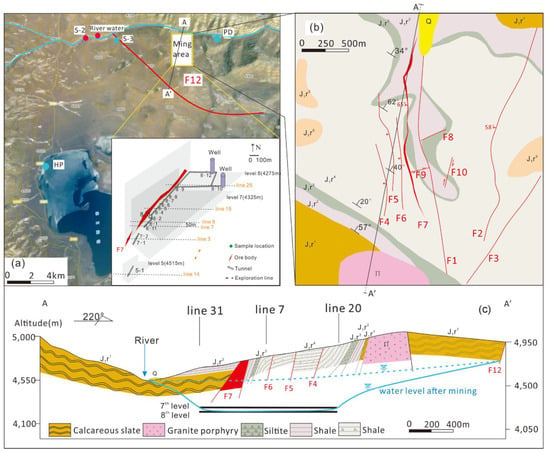
Figure 1.
The geological background, with the sampling location on the surface and the 8th level. (a) The sampling location; HP represents lake, S represents spring, and PD represents a tunnel on the surface. (b) The structure and lithology in the mining area, and (c) the profile of A-A’, representing the hydrogeological conceptual model.
The mining region exhibits a significant presence of faults, primarily attributed to the Zhegucu-Ridang fold bundle. A total of seven faults have been identified within this area, designated as F1, F2, F3, F4, F5, F6, F7, and F12 (Figure 1b). Among these, F7 serves as the principal ore-bearing fault; it governs the V orebody (identified as one specific orebody) and is characterized by an orientation of 265–295° with a dip angle ranging from 45° to 70°. This fault extends from the southern to the northern part of the mining area, measuring over 1000 m in length and varying in width from 1 to 30 m. The predominant minerals associated with this fault include galena, sphalerite, stibnite, limonite, pyrite, and calcite, with lesser amounts of clay and chlorite. To date, mining activities targeting the V orebody have been ongoing for a decade, while the extraction of other orebodies located along faults F1 to F6 remains in the planning phase. Additionally, two primary sets of joint fractures have been observed in the mining area, exhibiting dips of 295° and 125°, with dip angles between 80° and 90° [21,22].
The maximum depth of mining operations reaches 4275 m, corresponding to the eighth level (8th level), with an interval of 50 m separating each level (Figure 1a,c). The water level within the tunnels has receded to the eighth level, and the tunnels situated above this level have been drained to the south of exploration line 7.
2.2. Hydrogeological Conceptual Model
Landform: The elevation of the mining area ranges from 4600 m (north) to 5300 m (south), with an average slope gradient of 40°.
Precipitation: The annual average precipitation is 287.2 mm, the maximum monthly average precipitation is 88.0 mm, in July, and the minimum monthly average precipitation is 1.1 mm, in December.
Surface water: Sengbixiongqu represents the sole river within the mining region, characterized by an elevation of 4600 m on its western bank and approximately 4585 m on its eastern bank, establishing it as the lowest base level of erosion in the area. During the dry season, the river exhibits a flow rate of 0.3 m3/s. However, it experiences significant increases in flow from June to August each year, with a maximum recorded flow of approximately 5.0 m3/s, as determined through field investigations. Nariyongcuo, a saline lake, primarily receives its water from precipitation and snowmelt. It is situated approximately 6.5 km northeast of the Ⅴ orebody, with a water level elevation of around 4700 m and covering an area of approximately 26.8 km2. A surface watershed exists between the lake and the mining area, and there is no known direct connection via faults [23].
Groundwater: The average depth of groundwater in boreholes that expose the rock mass on both sides of fault F7, extending from the southern to the northern region, ranges from 110 m to 650 m. In areas of active mining, groundwater depths exceed 500 m, as evidenced by recent borehole data. Hydrological conductivity, determined through pumping tests within these rock masses, varies between 1.2 × 10−5 and 4.6 × 10−5 m/s. Field investigations conducted in the tunnel at the 8th level indicate that groundwater does not seep from the footwall of F7 in the majority of the area, suggesting that the calcareous slate rock mass exhibits a low water retention capacity. F7 is identified as the primary water-rich fault, with groundwater levels in the V orebody displaying a general trend of higher levels in the southern region and lower levels in the northern region. In situ tests conducted at the 8th level reveal that the hydraulic head in F7 ranges from 1 to 10 m (Figure 1c). Additionally, hydrological conductivity, as measured by water level recovery tests in F7, ranges from 1.4 × 10−4 to 2.3 × 10−4 m/s. Time-series data on water inflow from April 2021 to July 2023 at the 8th level indicate a weak correlation between flow rates and precipitation (Figure 2), with water inflow gradually decreasing over time from an initial rate of 0.11 to 0.15 m3/s to a later rate of 0.1 to 0.13 m3/s.
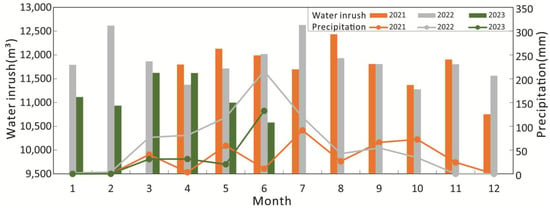
Figure 2.
The total volume of water inrush at the 8th level and the precipitation from 2021 to 2023 in mining area.
Springs: Hot springs are extensively found in the upper reaches of the Sengbixiongqu, exhibiting an average temperature of 57 °C and containing significant concentrations of elements such as boron (B), lithium (Li), and copper (Cu) [23]. These hot springs intermingle with river water and traverse the northern section of the mining area. Additionally, a cold spring emerges at location F12, which is situated on a regional geological structure in the southwestern part of the mining area (Figure 1a). The flow rates of both the hot springs and the cold spring remain consistent throughout the duration of mining activities.
3. Methods
3.1. Sampling and Analysis
To ascertain the sources of water inrush and their dynamic characteristics, both surface water and groundwater from fractures at the 8th level were collected in July (Figure 1a), with groundwater samples being re-collected in September. The following parameters were analyzed: stable isotopes of hydrogen (2H and 3H) and oxygen (18O), as well as major ions, including K+, Na+, Ca2+, Mg2+, F−, Cl−, Br−, SO42−, HCO3−, total dissolved solids (TDS), and trace elements such as B, Fe, Sr, Ba, Li, Rb, I, and Zn. These analyses were conducted using Picarro 2140-I (Picarro, Santa Clara, CA, USA), ICP-MS (Agilent, Santa Clara, CA, USA), and ICS-1500 (Thermo Fisher Scientific, Waltham, MA, USA) instruments at the Chinese Academy of Geology and Geophysics. Additionally, pH and oxidation–reduction potential (ORP) were measured in situ with the Aqua TROLL 500 device (Insitu, Inc., Fort Collins, CO, USA).
3.2. Geochemical Mixing Model
Grounded in the fundamental principle that mixing constitutes a physical process reliant on mass rather than active chemical reactions, various models have been developed, including EMMA, UNMIX, MIX, and PCA-LM [15,16,17,18,24,25]. Among the various models, MIX highlights the significance of uncertainties associated with component concentration in the end-member. The estimation of the mixing problem has been structured within a maximum likelihood framework. The primary concept underlying this methodology can be delineated in several stages: (1) Initialization, which entails establishing the initial mixing ratio through the application of the least squares method, under the assumption that the concentrations of the end-members are predetermined; (2) given the initial mixing ratio, the concentrations of the sample and end-members are estimated by optimizing the constructed maximum likelihood function; (3) the mixing ratio is recalculated based on the outcomes derived from the second stage; (4) the discrepancies between the results of the second and third stages are assessed until the residual is minimized. The principal equations are presented as follows.
The objective function is Equation (1), where yp is the ns 1-dimensional vector of species in the pth sample. Ap is the covariance matrix. F is the ns ne-dimensional matrix of all chemical analyses of end-members. is the ne 1-dimensional vector of mixing ratios satisfying the constraint that the mixing ratios add up to 1 (Equation (2)). Finally, the estimation problem is solved by the Lagrangian function Equation (3), where is a Lagrange multiplier.
The selection of these initial values (initial number of end-members and initial concentrations of tracers) often requires a deep understanding of the groundwater flow system, geological structure, and stratigraphic lithology of the study area. In this study, the identification of sources is initially guided by a conceptual model. The isotopic and concentration characteristics of multiple components are employed to assess the validity of the conceptual model and to identify potential sources. The end-member of a source serves as a representative sample. The selection criteria for the end-member adhere to the following principles: (1) It should exhibit extreme values of component concentration across multiple dimensions; (2) it should allow for the reconstruction of a maximum number of mixed samples; and (3) the end-member may vary over time due to changes in hydrogeochemical conditions.
Tracers are determined by correlation analysis of components. The chosen tracers must meet the following criteria: (1) They should provide a naturally high discrepancy in concentration among sources; (2) they must be conservative components during the mixing process; and (3) their quantity should exceed that of the sources.
4. Results
4.1. Conceptual Model
A two-dimensional conceptual model has been developed, taking into account the structural, lithological, and hydrogeological characteristics (Figure 1c). The model encompasses an area of approximately 5 km2, with the predominant lithology consisting of calcareous slate, along with mineralized and altered rock formations in F7. Potential sources of water inrush can be qualitatively deduced, specifically from F7 and from shallow fractures. The contribution of river water as a potential source remains ambiguous and is further examined in terms of its chemical composition. Nonetheless, the potential risks associated with river water are of significant concern for future deep mining operations.
In conclusion, the lithological characteristics, as well as the types of groundwater and surface water, exhibit minimal spatial variability at this scale. The hydrochemical properties are only marginally influenced by factors such as intense water–rock interactions, evaporation, and anthropogenic contaminants. Consequently, a geochemical mixing model is applicable for estimating the dynamics of water inrush by determining the mixing ratios of various sources over different time intervals.
4.2. Source Identification
The sources are categorized as water in F7 and water from shallow fractures based on the established conceptual model. In order to assess the collinearity among these sources and determine if river water constitutes a source, it is essential to conduct a more detailed analysis of the chemical characteristics of the sources.
Water in F7: The 3H values of water in F7 are below 2 TU, whereas the river water exhibits a value of 3.69 TU, suggesting that the age of the groundwater exceeds 70 years. The average oxidation–reduction potential (ORP) of the water in F7 is measured at −48.2 mV, which indicates a reducing environment. Although total dissolved solids (TDS) exhibit an increase in September, the freshest water sample (8-1) demonstrates the least increase, implying that the water in F7 is minimally influenced by chemical eluviation (Figure 3). Consequently, the water in F7 can be characterized as a source that does not correlate with contemporary precipitation.
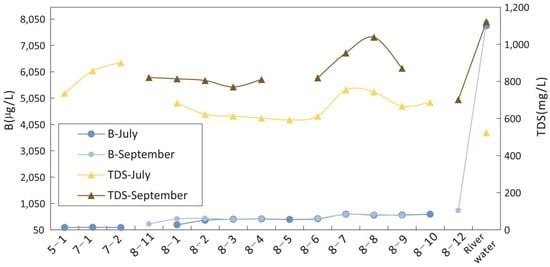
Figure 3.
B and TDS concentrations of the samples in July and September. The sampling IDs from left to right are closer to the river Sengbixiongqu.
Shallow fracture water: The hydrogeochemical characteristics are influenced by calcareous slate, which exhibits notable differences from the rock found in F7. Samples PD-1 and 8-12 were collected from the footwall of F7. The isotopic ratios of δ18O and δD in shallow fracture water are significantly impacted by precipitation. Overall, there is a slight shift in the δ18O and δD values towards the Global Meteoric Water Line (GMWL) between the two sampling periods, suggesting that mining activities have disrupted the shallow rock mass in the mining area, thereby facilitating the infiltration of contemporary precipitation into the tunnels. In contrast to the water in F7, the water in shallow fractures experiences considerable evaporation in July, followed by a notable shift above the GMWL in September (Figure 4). Furthermore, the δ18O and δD values of PD-1 indicate a greater degree of recycling compared to those of 8-12, as it was collected after a longer flow path. Additionally, the concentration of boron (B) in PD-1 demonstrates a more pronounced increase in September compared to the water in F7, suggesting enhanced chemical eluviation in the shallow fractures.
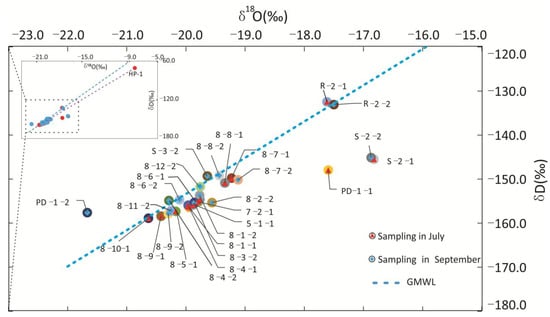
Figure 4.
Relationship between δ18O and δD in mining area (the number following the sampling ID represents the period: 8-1-1 represents July, and 8-1-2 represents September).
River water: River water interacts with the hot springs located upstream, and the distinctive elements found in the hot springs, such as boron (B), can serve as indicators for tracing the infiltration of river water into deeper aquifers. As illustrated in Figure 3, the concentrations of boron exhibit an increasing trend along the flow path, suggesting that sampling sites situated nearer to the river exhibit elevated concentrations of this component. Consequently, it can be inferred that river water acts as a source of water influx.
4.3. Tracer Selection
The correlation dynamics of various components are employed to conduct a preliminary assessment of their sensitivity to environmental disturbances (Figure 5). Initially, components exhibiting low correlation, specifically Ca2+, Mg2+, Sr, pH, Zn, NO3−, and SO42−, are excluded from further analysis, while the remaining components are retained for variability assessment [26,27]. The minimal fluctuation in the correlation coefficient across the two time periods suggests that these components exhibit conservative or covariant behavior under disturbed conditions. As illustrated in Figure 6, four distinct groups of components are delineated based on the observed variations in correlation coefficients, with Ni, Ba, I, and HCO3− being excluded due to their heightened sensitivity to environmental disturbances. Group 1 comprises 18O and D; group 2 includes TDS and SiO2; group 3 consists of F−, Cl−, Br−, Li, Rb, and B; and group 4 is made up of K+ and Na+. The variations in correlation coefficients among these groups indicate a lack of synchronization, while components within each group demonstrate covariant relationships.
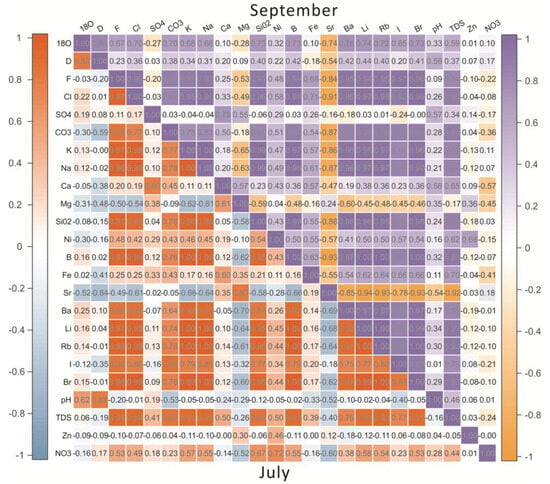
Figure 5.
The results of component correlations in July (lower triangular matrix) and September (upper triangular matrix).
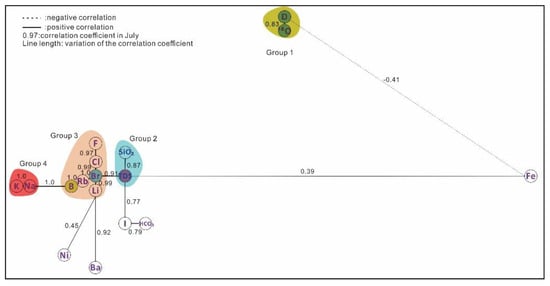
Figure 6.
Variation in the correlation coefficient among components between the two periods. The length of the line represents the variation; the solid line represents a positive correlation and the dash line represents a negative correlation. The correlation coefficients in July are labeled.
In the context of mixing models, generalized conservative tracers are characterized as components that do not undergo chemical reactions or water–rock interactions during the mixing process, as opposed to prior to mixing. This perspective allows for the inclusion of both traditionally conservative components, such as Cl−, and certain reactive components within the mixing model [28]. The isotopes 18O and D exhibit weak correlations with other components, suggesting that variations in environmental conditions and other components exert minimal influence on their concentrations. The correlation coefficient between 18O and D remains consistent across the months of July and September, indicating their conservative nature (Figure 5). Components categorized into groups 2, 3, and 4 are further refined based on the premise that the concentrations of these components in the mixtures are effectively constrained by those in the three source waters. As illustrated in Figure 7, Cl−-B and Cl−-Li demonstrate the most effective constraints and exhibit significant discrepancies in concentration among the sources, as all mixed-water samples fall within the designated mixing zone. Conversely, Cl−-K, Cl−-Na, SiO2-TDS, SiO2-Li, SiO2-B, and Cl−-Rb do not adequately constrain the mixed-water samples. Generally, an increased number of tracers can enhance the accuracy of the model; however, this approach may also introduce greater uncertainties due to measurement errors and the presence of weak chemical reactions during mixing. Consequently, to balance the number of components with the associated uncertainties, 18O, D, Cl−, B, and Li are selected as the primary tracers.
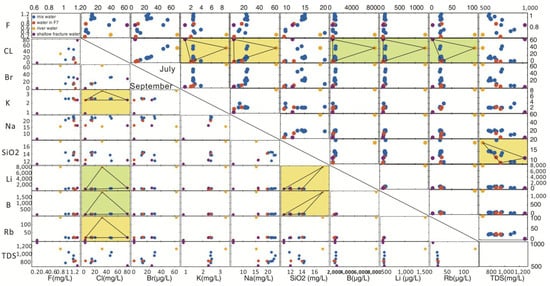
Figure 7.
The distribution of water samples in bivariate components in July and September. The triangles represent the mixing zone. Each mixing zone, consisting of potential tracers, is filled by yellow or green. The yellow mixing zone represents a bad constraint, and the green mixing zone represents a good constraint.
4.4. End-Member Selection
The concentrations of end-member components are established as the initial values within the model framework. When these initial values approximate the true concentrations of the sources, the model exhibits a high degree of robustness. Generally, samples characterized by extreme tracer concentrations are prioritized for selection [24,29], as such extreme values facilitate the development of a more comprehensive mixing model. Given the dynamic nature of mining operations and seasonal precipitation patterns, the characteristics of the end-members are subject to temporal variation. Consequently, the location of potential end-members should be situated closer to the mixing region when there is significant fluctuation in the component concentrations of the sources. As a result, the end-members may differ between the months of July and September.
End-member of water in F7: According to the established principles, the water sample collected from the 5th level (5-1-1), close to the undisturbed F7, can serve as a representative of the chemical characteristics of the water in F7 during the month of July. In September, these chemical characteristics are influenced by the process of chemical eluviation occurring in shallow fractures; therefore, a deeper sample, obtained from the 8th level (8-11-2), is considered a more appropriate end-member for analysis during September.
End-member of river water: Water samples HL-2-1 and HL-2-2 are determined as end-members in July and September, respectively.
End-member of shallow fracture water: The water in shallow fractures exhibits a reduced sensitivity to precipitation during the month of July (Figure 4). Furthermore, the elevation of PD-1 exceeds that of the river, thereby mitigating the influence of river water. Consequently, PD-1-1 is deemed an appropriate end-member for the month of July. In September, however, the chemical properties of shallow fracture water are altered due to precipitation and water–rock interactions, rendering PD-1-2 an unsuitable choice for that period. Conversely, sample 8-12-2, collected from the 8th level, is situated closer to the mixing zone and is less influenced by external factors, thereby providing a more accurate representation of the mixing processes (Figure 7).
4.5. Mixing Dynamics of Three Sources
The optimal solutions for the months of July and September are presented in Table 1. The corresponding values for these months are −7.44 and −1.12, respectively. The primary contributors to these values are the characteristic components B and Li, while the isotope 18O has the least contribution. This observation underscores the importance of components that exhibit significant variability among different sources.

Table 1.
The results of the mixing model using five tracers.
The discrepancies between the calculated and observed concentrations are illustrated in Figure 7 and Figure 8. The components of the three end-members have been inverted based on their initial values. Notably, the inverse δ18O and Cl values in the end-members exhibit greater variance compared to those in other samples, particularly in July. This phenomenon may be attributed to the sampling locations of HL-2-1 and PD-1-1, which are situated at a considerable distance from the mixing zone (the 8th level). Consequently, the components in these two samples may not accurately reflect the true characteristics of the end-members. These findings indicate that the mixtures contain substantial information regarding the end-members, and that the uncertainties arising from the initial inputs are reduced in the MIX method relative to other approaches where the end-members are predetermined [19]. Furthermore, the observed closer alignment between the computed and measured concentrations of D compared to those of 18O implies that D exhibits more conservative behavior than 18O during the mixing process.
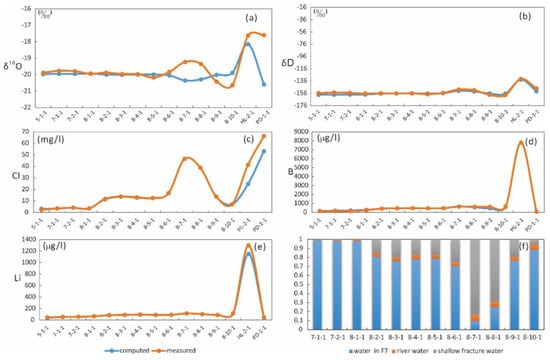
Figure 8.
The measured and computed component concentrations in July: (a) δ18O, (b) δD, (c) Cl, (d) B, and (e) Li. The mixing ratios of the three sources are shown in (f), and the sampling IDs from left to right are closer to the river Sengbixiongqu.
The mixing ratios indicate that, in July, the water sourced from F7 constitutes the largest proportion, with a mean value of 73.20% (Figure 8). This is followed by shallow fracture water, which accounts for a mean of 22.86%, while river water comprises the remaining portion, with a mean of 3.94%. Notably, the proportion of shallow fracture water increases as one approaches the disturbed areas resulting from mining activities. The highest ratios are observed at locations 8-7 (83.4%) and 8-8 (68.9%), where the presence of tunnel support structures suggests that the highly fractured rock mass facilitates the influx of shallow fracture water. Conversely, the proportion of river water increases with proximity to the river itself. The stable ratios observed at locations 8-7 (a slight increase to 7.1%) and 8-8 (a slight increase to 5.9%) imply that river water predominantly exhibits horizontal flow characteristics with a minimal hydraulic gradient. Consequently, it can be inferred that river water maintains a weak connection with groundwater, even under natural conditions. Additionally, field investigations revealed the presence of a substantial clay formation (exceeding 2 m in thickness) beneath the riverbed, which effectively inhibits the infiltration of river water.
The contributions of the three sources remained consistent in September, as illustrated in Figure 9. The average proportion of shallow fracture water increased to 23.2%, attributed to the heightened precipitation levels during this month. Notably, this proportion peaked at 45.5% and 47.9% on the 7th and 8th of August, respectively. Conversely, the average contribution of river water decreased to 1.42%, suggesting that a steeper hydraulic gradient from south to north inhibits the recharge of the 8th level by river water.
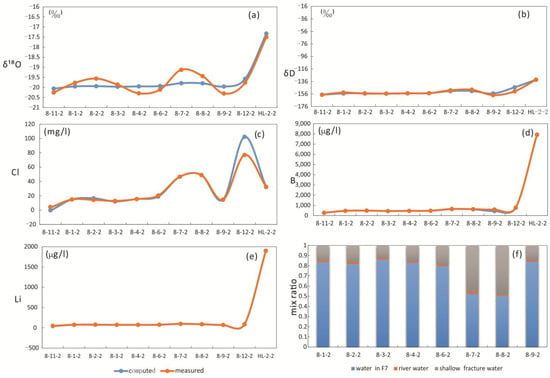
Figure 9.
The measured and computed component concentrations in September: (a) δ18O, (b) δD, (c) Cl, (d) B, and (e) Li. The mixing ratios of the three sources are shown in (f), and the sampling IDs from left to right are closer to the river Sengbixiongqu.
5. Discussion
This research underscores the significance of using hydrological conceptual models prior to the implementation of conventional water chemistry mixing models, emphasizing their essential function in informing the selection of tracer ions and end-members. The environmental alterations within the study area across various timeframes exert a considerable influence on the water chemistry mixing models, necessitating dynamic modifications to the critical parameters of the mixing model to accurately assess the contribution of river water during inflow events at the mine. To estimate the mixing ratios, five tracers (18O, D, Cl, B, and Li) were utilized, determined through correlation and variability analyses within the mixing model. The end-member contributions exhibit temporal variability across different periods, as illustrated in Figure 10. The findings indicate that water from F7 constitutes the predominant source, accounting for over 70% of the total, followed by shallow fracture water at more than 20%, while river water represents the least significant source at less than 4%. The dynamics of the mixing ratios suggest that tunnel water is minimally influenced by river water, with a slight increase in shallow fracture water observed in September. This understanding carries important implications for the design of waterproofing and drainage systems at the northern terminus of the mine’s tunnels.
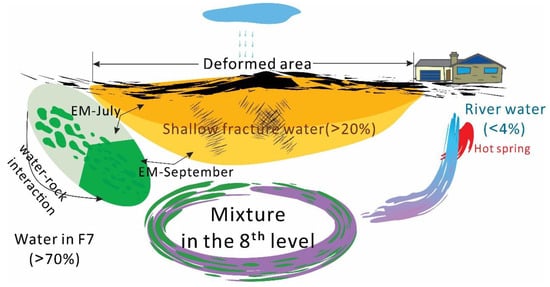
Figure 10.
The mixing model of three end-members (EMs).
Furthermore, it is noteworthy that subsequent measurements of river flow and drainage volume in the mining area (Figure 11), conducted using a water balance approach, indicated that this method was unable to differentiate between the shallow fissure water and the river water (Figure 10). Consequently, we estimate that the proportion of river water is approximately 20%, a conclusion that is likely to significantly elevate the design costs associated with the mine. Therefore, the hydrochemical mixing model demonstrates high sensitivity to changes in the source of water inrush and can play a significant role in the early warning of water inrush in mining areas.
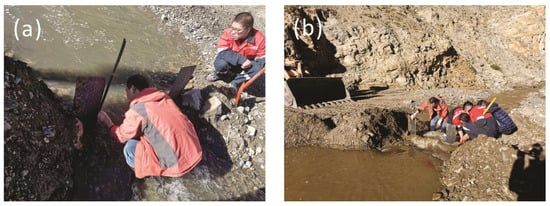
Figure 11.
Measurements of river flow both upstream (a) and downstream (b).
6. Conclusions
This research investigates the phenomenon of water inrush within mining tunnels. A mixing model, grounded in geochemical components, is employed to identify the sources of water inrush and to assess the dynamics of mixing over various time periods. We conclude that, in July, groundwater from the F7 fault dominated the tunnel inrush volume (>70%), while shallow fracture water accounted for up to 20% through mining-induced fractures, and river water, as a significant potential hazard, only contributed less than 4%. By September, shallow fracture water increased during the rainy season (averaging 23%), and the average proportion of river water decreased to 1.42%, with the spatial distribution of shallow fissure water and river water proportions gradually decreasing from north to south. Seasonal dynamics indicate that rivers do not pose a major threat to mine safety. This conclusion demonstrates the crucial role of the conceptual model established based on traditional hydrogeological and structural geological knowledge in the applicability of hydrochemical mixing models and initial source identification. Hydrogeochemistry further constrains the seasonal dynamics of mixing end-members and parameters. The model has high sensitivity to minor inrush sources such as river water in this study, which is of significance for warning mines, helping them to cope with potential sudden water inrushes and design forward-looking drainage systems.
Author Contributions
H.G.: writing—review and editing, writing—original draft, validation, supervision, project administration, methodology, investigation, formal analysis, conceptualization. Y.L.: writing—review, project administration, investigation. J.Z.: writing—review, project administration. H.L.: project administration, investigation. D.W., X.C. and L.Y.: investigation, writing—review. All authors have read and agreed to the published version of the manuscript.
Funding
This work was supported by the National Natural Science Foundation of China (41907174) and 2024ZRBSHZ022, China Geological Survey (DD20250501407, DD20251300114, DD20230500704, and DD20211381).
Data Availability Statement
The data presented in this study are available on request from the corresponding author. The data are not publicly available due to the secrecy policy.
Acknowledgments
Thanks to the members (Lanxiang Jia, Zhigang Sun, Jingliang Li, Xiaolin Wei, and Wangqing Zhala) of Tibet Huayu Mining Co., Ltd. for their support.
Conflicts of Interest
The authors declare no conflict of interest.
References
- Dong, S.; Zhou, W.; Wang, H. Introduction to Special Issue on Mine Water Inrushes: Risk Assessment, Mitigation, and Prevention. Mine Water Environ. 2021, 40, 321–323. [Google Scholar] [CrossRef]
- Wu, Q.; Dong, S.; Li, B.; Zhou, W. Mine Water Inrush. In Environmental Geology; LaMoreaux, J.W., Ed.; Springer: New York, NY, USA, 2019; pp. 127–148. [Google Scholar]
- Gai, Q.; Gao, Y.; Zhang, X.; He, M. A New Method for Evaluating Floor Spatial Failure Characteristics and Water Inrush Risk Based on Microseismic Monitoring. Rock Mech. Rock Eng. 2024, 57, 2847–2875. [Google Scholar] [CrossRef]
- Wang, D.; Ju, Q.; Wang, Y.; Hu, Y.; Liu, Q.; Chai, H.; Liu, Y. Source identification of mine water inrush based on the exponential whitenization function and the grey situation decision model. Energy Explor. Exploit. 2022, 40, 1217–1235. [Google Scholar] [CrossRef]
- Gu, H.; Ma, F.; Guo, J.; Li, S.; Deng, G. Source and pattern identification of ground deformation based on non-negative matrix factorization: A case study. Bull. Eng. Geol. Environ. 2023, 82, 141. [Google Scholar] [CrossRef]
- Knuth, K.H.; Vaughan, H.G. Convergent Bayesian Formulation of Blind Source Separation and Electromagnetic Source Separation. In Maximum Entropy and Bayesian Methods Garching, Germany 1998; Springer: Dordrecht, The Netherlands, 1998. [Google Scholar]
- Vivek, N.; Roland, P. Generalized blind delayed source seperation model for online noninvasive twin fetal sound seperation: A phantom study. J. Med. Syst. 2007, 32, 123–135. [Google Scholar]
- Zhang, W.; Chen, X.; Tan, H.; Zhang, Y.; Cao, J. Geochemical and isotopic data for restricting seawater intrusion and groundwater circulation in a series of typical volcanic islands in the South China Sea. Mar. Pollut. Bull. 2015, 93, 153–162. [Google Scholar] [CrossRef]
- Buttle, J.M. Isotope Hydrograph Separation of Runoff Sources. Encycl. Hydrol. Sci. 2005. [CrossRef]
- Zhang, M.; Chen, L.; Hou, X.; Hu, Y.; Zhang, J.; Zhang, Y.; Cai, X. Determination of spatiotemporal variations and mixed patterns for a multi-aquifer system in the Sulin mining area based on analyses of hydrochemical and isotopic characteristics. J. Geochem. Explor. 2024, 266, 107561. [Google Scholar] [CrossRef]
- Luo, A.; Dong, S.; Wang, H.; Ji, Z.; Wang, T.; Hu, X.; Wang, C.; Qu, S. Impact of long-term mining activity on groundwater dynamics in a mining district in Xinjiang coal Mine Base, Northwest China: Insight from geochemical fingerprint and machine learning. Environ. Sci. Pollut. Res. 2024, 31, 32136–32151. [Google Scholar] [CrossRef]
- Tubau, I.; Vazquez-Sune, E.; Jurado, A.; Carrera, J. Using EMMA and MIX analysis to assess mixing ratios and to identify hydrochemical reactions in groundwater. Sci. Total Environ. 2014, 470–471, 1120–1131. [Google Scholar] [CrossRef]
- Yuan, H.; Xu, Z.; Sun, Y.; Zhang, L.; Chen, G. A quantitative composition calculation model of mine water source based on “emblematic ions”. Hydrogeol. J. 2024, 32, 913–923. [Google Scholar] [CrossRef]
- Mathurin, F.A.; Åström, M.E.; Laaksoharju, M.; Kalinowski, B.E.; Tullborg, E.L. Effect of tunnel excavation on source and mixing of groundwater in a coastal granitoidic fracture network. Environ. Sci. Technol. 2012, 46, 12779–12786. [Google Scholar] [CrossRef]
- Christophersen, N.; Hooper, R.P. Multivariate analysis of stream water chemical data: The use of principal components analysis for the end-member mixing problem. Water Resour. Res. 1992, 28, 99–107. [Google Scholar] [CrossRef]
- James, A.L.; Roulet, N.T. Investigating the applicability of end-member mixing analysis (EMMA) across scale: A study of eight small, nested catchments in a temperate forested watershed. Water Resour. Res. 2006, 42, W08434. [Google Scholar] [CrossRef]
- Mackas, D.L.; Denman, K.L.; Bennett, A.F. Least squares multiple tracer analysis of water mass composition. J. Geophys. Res. Ocean. 1987, 92, 2907–2918. [Google Scholar] [CrossRef]
- Laaksoharju, M.; Skårman, C.; Skårman, E. Multivariate mixing and mass balance (M3) calculations, a new tool for decoding hydrogeochemical information. Appl. Geochem. 1999, 14, 861–871. [Google Scholar] [CrossRef]
- Carrera, J.; Vazquez-Sune, E.; Castillo, O.; Sanchez-Vila, X. A methodology to compute mixing ratios with uncertain end-members. Water Resour. Res. 2004, 40, 3687–3696. [Google Scholar] [CrossRef]
- QIing, C.; Zhang, Z.; Zhang, L.; Li, G.; Dong, S.; Wang, Y.; Gao, K. The element zonation characteristics of No. XV ore body in Zhaxikang lead-zinc polymetallic deposit, Tibet. Sediment. Geol. Tethyan Geol. 2023, 43, 130–144. [Google Scholar]
- Gu, H.; Ni, H.; Wang, Y.; Liu, Y.; Zhang, Z. Hydrogeochemical Characteristics and Impact of Arsenic Released from a Gold Deposit in Tibet. Mine Water Environ. 2020, 39, 746–757. [Google Scholar] [CrossRef]
- Zhou, Q.; Li, W.; Qing, C.; Lai, Y.; Tian, E. Origin and tectonic implications of the Zhaxikang Pb–Zn–Sb–Ag deposit in northern Himalaya: Evidence from structures, Re–Os–Pb–S isotopes, and fluid inclusions. Miner. Depos. 2017, 53 (Suppl. S2), 1–16. [Google Scholar] [CrossRef]
- Wang, Y.; Gu, H.; Li, D.; Lyu, M.; Song, R. Hydrochemical characteristics and genesis analysis of geothermal fluid in the Zhaxikang geothermal field in Cuona County, southern Tibet. Environ. Earth Sci. 2021, 80, 415. [Google Scholar] [CrossRef]
- Gu, H.; Ni, H.; Ma, F.; Liu, G.; Hui, X.; Cao, J. Using mixing model to interpret the water sources and ratios in an under-sea mine. Nat. Hazards 2020, 104, 1705–1722. [Google Scholar] [CrossRef]
- Hu, S.; Mcdonald, R.; Martuzevicius, D.; Biswas, P.; Grinshpun, S.A.; Kelley, A.; Reponen, T.; Lockey, J.; Lemasters, G. UNMIX modeling of ambient PM(2.5) near an interstate highway in Cincinnati, OH, USA. Atmos. Environ. 2006, 40, 378–395. [Google Scholar] [CrossRef]
- Barthold, F.K.; Tyralla, C.; Schneider, K.; Vaché, K.B.; Frede, H.-G.; Breuer, L. How many tracers do we need for end member mixing analysis (EMMA)? A sensitivity analysis. Water Resour. Res. 2011, 47, W08519. [Google Scholar] [CrossRef]
- Hooper, R.P. Diagnostic tools for mixing models of stream water chemistry. Water Resour. Res. 2003, 39, 249–256. [Google Scholar] [CrossRef]
- Schemel, L.E.; Cox, M.H.; Runkel, R.L.; Kimball, B.A. Multiple injected and natural conservative tracers quantify mixing in a stream confluence affected by acid mine drainage near Silverton, Colorado. Hydrol. Process. 2010, 20, 2727–2743. [Google Scholar] [CrossRef]
- Valder, J.F.; Long, A.J.; Davis, A.D.; Kenner, S.J. Multivariate statistical approach to estimate mixing proportions for unknown end members. J. Hydrol. 2012, 460–461, 65–76. [Google Scholar] [CrossRef]
Disclaimer/Publisher’s Note: The statements, opinions and data contained in all publications are solely those of the individual author(s) and contributor(s) and not of MDPI and/or the editor(s). MDPI and/or the editor(s) disclaim responsibility for any injury to people or property resulting from any ideas, methods, instructions or products referred to in the content. |
© 2025 by the authors. Licensee MDPI, Basel, Switzerland. This article is an open access article distributed under the terms and conditions of the Creative Commons Attribution (CC BY) license (https://creativecommons.org/licenses/by/4.0/).